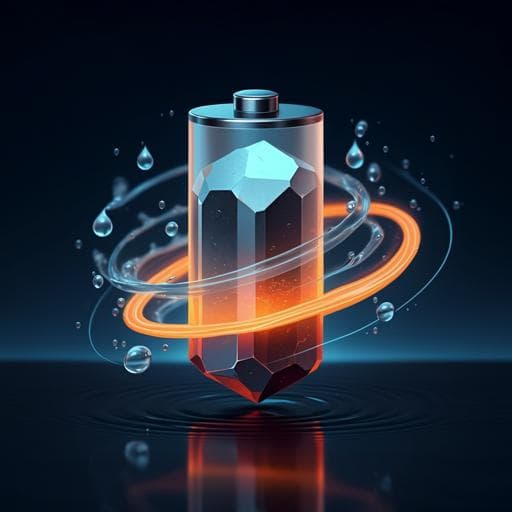
Engineering and Technology
Toward waterproof magnesium metal anodes by uncovering water-induced passivation and drawing water-tolerant interphases
Y. Li, X. Feng, et al.
This groundbreaking research conducted by Yuanjian Li, Xiang Feng, Gaoliang Yang, Wei Ying Lieu, Lin Fu, Chang Zhang, Zhenxiang Xing, Man-Fai Ng, Qianfan Zhang, Wei Liu, Jun Lu, and Zhi Wei Seh unveils the formation of detrimental MgH₂ during the passivation of magnesium in aqueous environments. Discover how a revolutionary hydrophobic interphase design results in stable cycling of magnesium batteries, paving the way for advancements in multivalent metal battery technology.
~3 min • Beginner • English
Introduction
Magnesium metal offers high volumetric capacity (3833 mAh cm−3), a low redox potential (−2.37 V vs. SHE), earth abundance, and a dendrite-resistant nature, making it an attractive anode for next-generation batteries. However, Mg metal batteries suffer from poor rechargeability due to severe passivation in conventional electrolytes. Water, even in trace amounts (>20 ppm), critically contributes to Mg–electrolyte interfacial passivation: (i) it alters solvation structures and promotes decomposition of Mg–anion ion pairs, forming passivating interphases; and (ii) it directly reacts with Mg to form MgO and Mg(OH)2, raising overpotentials and hindering reversible Mg plating/stripping. Although approaches such as water scavengers and artificial interphases have been explored, achieving Mg anodes that remain functional after direct water contact remains challenging due to incomplete understanding of water-induced passivation mechanisms. This study addresses that gap by identifying MgH2 as a previously overlooked component in water-induced passivation on Mg and by designing a simple, water-tolerant, pencil-drawn graphite (PDG) interphase that protects Mg and enables reversible cycling even after water exposure.
Literature Review
A clear understanding of SEI/passivation composition is vital for stabilizing reactive metal anodes. For Li metal, the existence and role of LiH in the SEI have been debated, with multiple studies confirming LiH formation via parasitic reactions and gas evolution; LiH’s poor electronic conductivity and brittleness can be detrimental, though its Li-ion conductivity may aid Li diffusion. Similar debates exist for NaH in sodium systems. In contrast, MgH2 studies are sparse. Recent work reported reversible MgH2 formation on a CuSe cathode in aqueous carbonate-based electrolytes, enabling Mg–H+ energy storage. However, the formation, spatial distribution, and role of MgH2 on Mg metal anodes remained unclear prior to this study. Prior strategies to mitigate water effects include water-reactive scavengers and artificial SEIs (e.g., polymeric layers, MOF coatings, halogenated compounds), but their robustness against direct water exposure to Mg anodes has been largely unexplored.
Methodology
Electrode preparation: Commercial Mg foil (99.9%, 0.1 mm) was polished to a shiny surface. A graphite-based protective layer was applied by drawing with a commercial 2B pencil to form a pencil-drawn graphite (PDG) interphase. Average PDG thickness ~2 µm and mass loading ~0.2 mg cm−2. Discs (12.7 mm diameter) were punched for cell assembly.
Water exposure tests: 30 µL water droplets were placed on pristine Mg or PDG-Mg surfaces to visually assess wetting, bubble evolution, and passivation behavior over time.
Electrolytes: Non-aqueous electrolyte: 0.3 M Mg(OTf)2 + 0.2 M MgCl2 in 1,2-dimethoxyethane (DME) (prepared by dissolving 1.5 mmol Mg(OTf)2 and 1 mmol MgCl2 in 5 mL DME). Aqueous electrolyte: 5 M MgCl2 (5 mmol in 1 mL DI water).
Characterization: XRD (Bruker D8, Cu Kα), Raman (532 nm), XPS (Thermo Fisher, Al Kα), SEM (JEOL 7600 F) with EDX, TEM (FEI Talos F200X), and TOF-SIMS (IONTOF). TOF-SIMS and Raman were used to identify Mg(OH)2, MgO, and MgH2 signatures and their depth distributions after water treatment. Samples for post-cycling analysis were handled in Ar glovebox (H2O, O2 < 0.1 ppm) with airtight transfer.
Electrochemical testing: CR2032 coin cells at 25 °C with Whatman GF/D separator and 80 µL electrolyte. Symmetric Mg||Mg (or PDG-Mg||PDG-Mg) cells cycled galvanostatically. Full cells: Mo6S8 cathode (Mo6S8:Super P:PVDF = 8:1:1, coated on Ni, dried at 60 °C overnight; loading ~1.42 mg cm−2). Voltage window 0.2–2.0 V vs. Mg2+/Mg, rate 0.5 C. EIS: 100 kHz–0.1 Hz, 5 mV amplitude.
Computations: DFT (VASP) with PBE-GGA, PAW, 600 eV cutoff, Gamma-centered k-meshes, energy convergence 1×10−5 eV, force convergence 1×10−2 eV Å−1, 15 Å vacuum, DFT-D3 vdW correction. Bader charge analysis (Henkelman code). Mg adatom adsorption on MgH2(001), Mg(OH)2(001), MgO(001), and O-containing graphite. CI-NEB for Mg diffusion barriers.
Simulations: COMSOL Multiphysics 2D (8×9 µm2) symmetric cell model with either a compact passivation layer or stacked graphite flakes at the anode surface. Initial Mg concentration 500 mol m−3; applied average current density 1.0 mA cm−2. Calculated Mg2+ concentration distribution, electric field, and overpotential.
Key Findings
- Identification of MgH2 in water-induced Mg passivation: Beyond MgO and Mg(OH)2, MgH2 forms via H2 generated during Mg–H2O reactions: Mg + 2H2O → Mg(OH)2 + H2 (ΔH = −359.1 kJ/mol); Mg + H2O → MgO + H2 (ΔH = −285.9 kJ/mol); Mg + H2 → MgH2 (ΔH = −86.0 kJ/mol).
- TOF-SIMS/Raman evidence: TOF-SIMS detected MgOH (m/z 40.988), MgO (m/z 30.978), and MgH (m/z 24.995) ions after 30 min water treatment of pristine Mg. MgH signal is ~10× weaker than MgOH/MgO. Depth profile shows MgH intensity peak at ~50 nm; MgO persists through >1 µm thickness, indicating a thick passivation layer. 3D reconstructions show Mg(OH)2 concentrated within outer ~100 nm, MgO within ~300 nm, and sparse MgH throughout. Raman bands confirm MgO (278, 445 cm−1), MgH2 (311 cm−1), and Mg(OH)2 (725, 810 cm−1). No MgH2 detected on pristine Mg before or after 30 min air exposure.
- PDG interphase properties and protection: PDG layer is graphitic (XRD peak at 26.4° (002), Raman D~1350 cm−1 and G~1580 cm−1 with ID>IG indicating disorder from exfoliation). XPS C 1s shows graphite C (284.6 eV), C–O (286.0 eV), and C=O (287.6 eV); O-containing groups enhance metallophilicity. PDG is hydrophobic: water droplets show minimal spreading and no bubble evolution; underlying Mg is shielded, suppressing passivation and preventing MgH2 formation during water exposure. PDG thickness ~1–2 µm; flakes are multi-layer graphite hundreds of nm in size.
- Electronic stability: Calculated band gaps: MgH2 4.05 eV, Mg(OH)2 6.38 eV, MgO 6.02 eV. MgH2 has smaller gap and a narrow electrochemical stability window (ESW ~0.43 V) vs. Mg(OH)2 (2.02 V) and MgO (3.05 V), making MgH2 more prone to interfacial degradation.
- Interfacial adsorption and affinity: DFT adsorption energies (H2O vs. Mg adatom, eV): MgH2 (−1.03 vs. −0.50), Mg(OH)2 (−0.48 vs. −0.47), MgO (−0.77 vs. −0.52) indicate hydrophilic, magnesiophobic passivation surfaces. O-containing graphite shows stronger Mg binding (−1.62 eV) than H2O (−0.28 eV), establishing Mg-enriched, H2O-depleted interfacial regions. Bader charges: Mg→O-graphite donation ~0.9 e (vs. MgH2 0.1 e, Mg(OH)2 0.5 e, MgO 0.2 e), indicating high magnesiophilicity of PDG.
- Mg transport: Diffusion barriers (CI-NEB): O-containing graphite 0.02 eV, Mg(OH)2 0.03 eV, MgH2 0.17 eV, MgO 0.20 eV, supporting faster Mg transport on PDG than on passivation compounds.
- COMSOL simulations: Passivated Mg shows severe Mg2+ depletion at interface and strong electric field, causing high overpotential. With PDG, interfacial Mg2+ concentration increases from 1.55 to 480 mol m−3; overpotential drops from 1.05 to 0.20 V; Mg flux and electric field become uniform.
- Electrochemical performance after water exposure:
• Symmetric cells (0.3 M Mg(OTf)2 + 0.2 M MgCl2 in DME): Water-treated pristine Mg deactivates with oscillatory voltage; water-treated PDG-Mg cycles stably >900 h at 1.0 mA cm−2 and 1.0 mAh cm−2 with overpotential ~200 mV initially, ~250 mV after 900 h. At 3.0 mA cm−2 and 3.0 mAh cm−2, water-treated pristine Mg fails; PDG-Mg cycles >400 h; PDG-Mg also operates up to 5.0 mA cm−2.
• Post-mortem: Pristine Mg shows porous, cracked surface and ~0.8 µm height variation; PDG-Mg remains compact/flat with ~0.35 µm variation. XPS shows reduced MgO/Mg(OH)2/MgF2 and absence of MgCO3 on PDG-Mg; metallic Mg signal (Mg 2p ~49.4 eV) evident; lower interfacial resistance.
• Full cells (PDG-Mg||Mo6S8, 0.5 C): Initial 47.2 mAh g−1, 42.1 mAh g−1 after 500 cycles (89.2% retention), comparable to untreated Mg anode cells (92.3% after 500 cycles). Capacity fluctuations attributed to temperature variations are reproducible.
• Aqueous electrolyte (5 M MgCl2): PDG-Mg symmetric cell stable >100 h; PDG-Mg||Mo6S8 full cell shows relatively stable cycling.
- Practicality: PDG interphase is solvent-free, low-cost, scalable (6.5×6 cm2 foils demonstrated), and effective across conventional and chloride-free Mg electrolytes, and with intentional H2O additives.
Discussion
This work resolves a key missing piece in the understanding of water-induced passivation of Mg metal anodes by identifying MgH2 as a co-constituent with MgO and Mg(OH)2. The formation pathway proceeds via water-driven hydrogen evolution, with nascent H2 reacting with Mg to form MgH2. Experimental TOF-SIMS and Raman analyses reveal the spatial distribution of these phases, while computations show that MgH2, Mg(OH)2, and MgO are collectively magnesiophobic and hydrophilic, impeding Mg2+ adsorption/transport and promoting concentration polarization, high interfacial electric fields, and large overpotentials. In contrast, the designed pencil-drawn graphite (PDG) interphase is hydrophobic and magnesiophilic, with strong Mg adsorption, low Mg diffusion barriers, and metallic-like conductivity, enabling uniform Mg flux and reduced overpotentials. The PDG layer effectively prevents water ingress, suppresses parasitic reactions (including MgH2 formation), and stabilizes the Mg/electrolyte interface. Consequently, Mg anodes maintain long-term cycling stability even after direct water exposure in both symmetric and full cells, including operation in aqueous electrolytes. These findings directly address the research question of how water passivates Mg and how to engineer a robust, water-tolerant anode interface.
Conclusion
The study uncovers MgH2 as a crucial component in water-induced Mg passivation, elucidates its formation mechanism and spatial distribution, and demonstrates that conventional passivation products (MgH2, Mg(OH)2, MgO) are hydrophilic, magnesiophobic, and unfavorable for Mg2+ transport. A simple, scalable, pencil-drawn graphite interphase provides hydrophobic protection and magnesiophilic, fast-ion-transport pathways, enabling Mg anodes to operate stably after water exposure. Water-treated PDG-Mg achieves >900 h symmetric-cell cycling at 1 mA cm−2, robust performance at higher currents, and 500-cycle full-cell stability with Mo6S8, and functions in aqueous electrolytes. This approach offers a low-cost, solvent-free route to waterproof Mg anodes and may extend to other water-sensitive battery chemistries. Future work could quantify MgH2 formation under varied conditions, optimize PDG chemistry/thickness and scalability, and explore broader cathode/electrolyte compatibility, high areal capacities, and pouch-cell demonstrations.
Limitations
Related Publications
Explore these studies to deepen your understanding of the subject.







